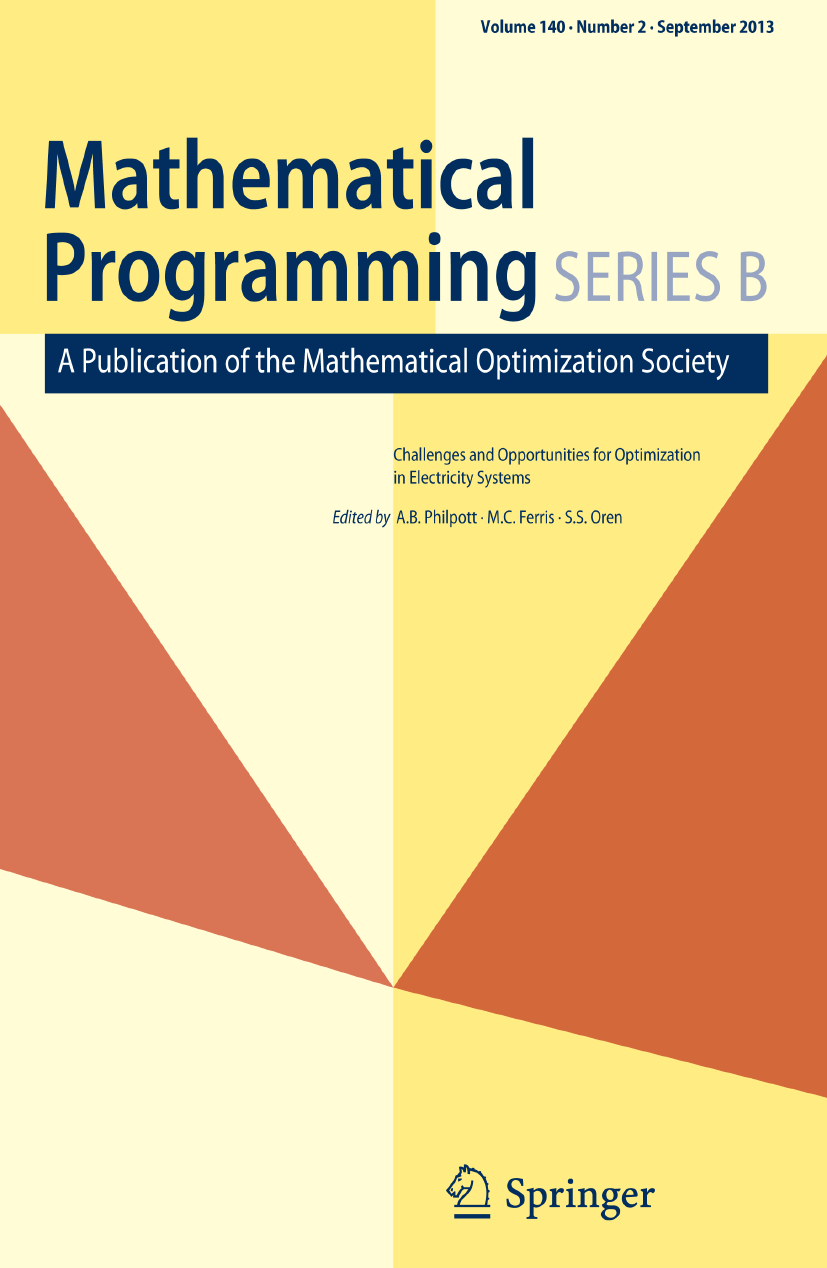link.springer.com/10.1007/BF02614433
Preview meta tags from the link.springer.com website.
Linked Hostnames
21- 27 links tolink.springer.com
- 21 links toscholar.google.com
- 16 links towww.emis.de
- 10 links towww.springernature.com
- 8 links towww.ams.org
- 7 links todoi.org
- 2 links tocitation-needed.springer.com
- 2 links tosupport.springernature.com
Thumbnail

Search Engine Appearance
https://link.springer.com/10.1007/BF02614433
An exact duality theory for semidefinite programming and its complexity implications - Mathematical Programming
In this paper, an exact dual is derived for Semidefinite Programming (SDP), for which strong duality properties hold without any regularity assumptions. It
Bing
An exact duality theory for semidefinite programming and its complexity implications - Mathematical Programming
https://link.springer.com/10.1007/BF02614433
In this paper, an exact dual is derived for Semidefinite Programming (SDP), for which strong duality properties hold without any regularity assumptions. It
DuckDuckGo
An exact duality theory for semidefinite programming and its complexity implications - Mathematical Programming
In this paper, an exact dual is derived for Semidefinite Programming (SDP), for which strong duality properties hold without any regularity assumptions. It
General Meta Tags
93- titleAn exact duality theory for semidefinite programming and its complexity implications | Mathematical Programming
- charsetUTF-8
- X-UA-CompatibleIE=edge
- applicable-devicepc,mobile
- viewportwidth=device-width, initial-scale=1
Open Graph Meta Tags
6- og:urlhttps://link.springer.com/article/10.1007/BF02614433
- og:typearticle
- og:site_nameSpringerLink
- og:titleAn exact duality theory for semidefinite programming and its complexity implications - Mathematical Programming
- og:descriptionIn this paper, an exact dual is derived for Semidefinite Programming (SDP), for which strong duality properties hold without any regularity assumptions. Its main features are: (i) The new dual is an explicit semidefinite program with polynomially many variables and polynomial size coefficient bitlengths. (ii) If the primal is feasible, then it is bounded if and only if the dual is feasible. (iii) When the primal is feasible and bounded, then its optimum value equals that of the dual, or in other words, there is no duality gap. Further, the dual attains this common optimum value. (iv) It yields a precise theorem of the alternative for semidefinite inequality systems, i.e. a characterization of theinfeasibility of a semidefinite inequality in terms of thefeasibility of another polynomial size semidefinite inequality.The standard duality for linear programming satisfies all of the above features, but no such explicit gap-free dual program of polynomial size was previously known for SDP, without Slater-like conditions being assumed. The dual is then applied to derive certain complexity results for SDP. The decision problem of Semidefinite Feasibility (SDFP), which asks to determine if a given semidefinite inequality system is feasible, is the central problem of interest, he complexity of SDFP is unknown, but we show the following: (i) In the Turing machine model, the membership or nonmembership of SDFP in NP and Co-NP is simultaneous; hence SDFP is not NP-Complete unless NP=Co-NP. (ii) In the real number model of Blum, Shub and Smale, SDFP is in NP∩CoNP.
Twitter Meta Tags
6- twitter:site@SpringerLink
- twitter:cardsummary_large_image
- twitter:image:altContent cover image
- twitter:titleAn exact duality theory for semidefinite programming and its complexity implications
- twitter:descriptionMathematical Programming - In this paper, an exact dual is derived for Semidefinite Programming (SDP), for which strong duality properties hold without any regularity assumptions. Its main features...
Item Prop Meta Tags
3- position1
- position2
- position3
Link Tags
9- apple-touch-icon/oscar-static/img/favicons/darwin/apple-touch-icon-6ef0829b9c.png
- canonicalhttps://link.springer.com/article/10.1007/BF02614433
- icon/oscar-static/img/favicons/darwin/android-chrome-192x192.png
- icon/oscar-static/img/favicons/darwin/favicon-32x32.png
- icon/oscar-static/img/favicons/darwin/favicon-16x16.png
Links
106- http://scholar.google.com/scholar_lookup?&title=An%20Introduction%20to%20Convex%20Polytopes&publication_year=1983&author=Br%C3%B8ndsted%2CA.
- http://scholar.google.com/scholar_lookup?&title=An%20algorithmic%20analysis%20of%20multiquadratic%20and%20semidefinite%20programming%20problems&publication_year=1993&author=Ramana%2CM.V.
- http://scholar.google.com/scholar_lookup?&title=An%20interior%20point%20method%20for%20minimizing%20the%20maximum%20eigenvalue%20of%20a%20linear%20combination%20of%20matrices&publication_year=1991&author=Jarre%2CF.
- http://scholar.google.com/scholar_lookup?&title=Combinatorial%20optimization%20with%20interior%20point%20methods%20and%20semi-definite%20matrices&publication_year=1991&author=Alizadeh%2CF.
- http://scholar.google.com/scholar_lookup?&title=Computers%20and%20Intractability%3A%20A%20Guide%20to%20the%20Theory%20of%20NP-completeness&publication_year=1979&author=Garey%2CM.R.&author=Johnson%2CD.S.